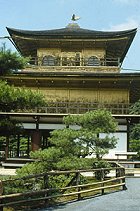Muromachi Period |
|
|
The Muromachi period represents the period in which the architecture of Japan is finally completely free of influence from outside cultures. Spanning a period from 1392 until 1573 AD, the temples of this period relied heavily on the influence of domestic architectural design, even more so than during the Heian period. While many Zen temples continued to use the Karayo style of bracketing from China, virtually everything else was of a Japanese style of architecture. The other bracketing developments from the previous Kamakura period did not survive into the Muromachi period as the Japanese strived to create their own style of architecture and not one that had been carried over from China. They wanted a style that would fit into their world of carefully planned landscape gardens, and the practice of the tea ceremony and flower arranging. It is these ideals that were carried into the design of temple architecture. The Muromachi period also marked a period of great civil unrest and as a result many of the temples from this period were lost. As a result of civil wars and feuds, the architecture of this period also evolved to fit the mindset of the warlords that controlled the country. The shoguns of this period were more interested in displaying their wealth, delicacy and their adeptness at rites and ceremonies that revolved around the aesthetics of tea ceremonies and flower arrangements. As a result of their lack of attention towards political matters, control of the country was always in a state of unrest and led to the devastation caused by war. A major style of architecture that developed during this period was the Shoin style of architecture. Literally meaning “study,” it became the accepted style of reading rooms for the feudal lords and later Zen monks. It often contained raised platforms for reading and small alcoves that acted as bookshelves or desks. The rooms were divided up using a screen called a fusuma, while the exterior walls were enclosed using shoji screens.
|

